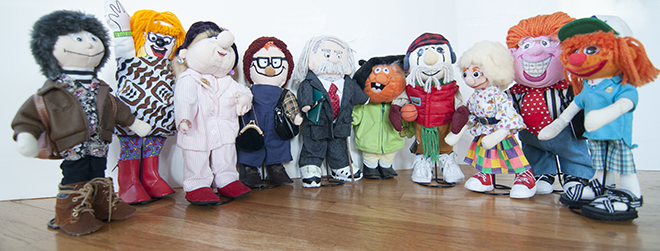About Lora's Dialogs. Part 2

Left to right: Sasha, Natasha, Great-grandmother, Nina Stepanovna, Ivan Petrovich, Professor Borodin, Great-grandfather, Masha, Kolya, Petya.
Sasha, Natasha, Masha, and Petya are American students studying Russian; in Part 1 they are in the USA, in Part 2 then are in a generalized Russian city.
Nina Stepanovna and Ivan Petrovich are their teachers. They gave the students their Russian nicknames.
Why the dolls?
The characters in this story speak standard conversational Russian; they are not fairy tale figures.
Yet there is something slightly unrealistic about them. Most of the time, this creates a humorous effect.
If you take humor out of learning, the process may become too dry. Humor, of course, is a personal thing,
and you may or may not laugh. But do try to embrace the author's light-hearted tone. We think you'll
enjoy it. She does: that's why she made these dolls.
Using this course
Lora Paperno wrote the first version of these situational dialogs for her first-year
Russian language course at Cornell University. Since then, she has revised and expanded them several times,
and they are still in use. The present edition was revised in 2016 to adjust the language to the ever-changing reality.
At Cornell, Lora's Dialogs are taught along with Beginning Russian by Leed, Nakhimovsky, and Nakhimovsky:
the textbook introduces the grammar, the dialogs are used for conversation. However, they can be
used on their own or with another textbook because all grammar references from Beginning Russian are included on this
website and are only a mouse click away. For vocabulary help, you can click any word in the Russian
text and see its dictionary entry. These entries are not simplified glosses. Offering simplified grammar
or glosses would go against our teaching philosophy. All grammar explanations and dictionary entries
are written with an intelligent and curious reader in mind.
Credits
The author is grateful to her friends Richard L. Leed and Alice and Sasha Nakhimovsky for allowing her
to use practically all grammatical sections of their book, Beginning Russian, from Slavica Publishers.
The dictionary entries come from The Russian Dictinary Tree by Slava Paperno and Richard L. Leed,
Lexicon Bridge Publishers. Essential information about using the dictionary is presented in another section
of this website. The sound was recorded by Lora and Slava Paperno. The website was designed and
programmed by Slava Paperno. The very first (printed) edition was
illustrated by photographs taken in Russia by Richard D. Sylvester; they are not used on this website,
but at the time they were an important contribution to the concept. We are also grateful to Max Lifflander
for his contribution to the preparation of the 2016 edition of the website.
The Consortium for Language Teaching and Learning generously supported this project.